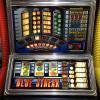Haven't posted much recently on the 'Tales from the workshop' but this one was a corker so worth documenting.
A couple of Sys1 boards were giving me the run around. They'd already been returned but failed soon after! The trouble with these boards is the dreaded green plague gets in everywhere even where it doesn't show and once repaired, even after soak testing, can sometimes fail shortly after. In the case of these two, one had the CPU fail (which looked really clean) and the other the sound chip failed causing (apart from bad sounds) no dip switches.
So, the first one with the CPU fail burst into life with a new CPU but there was no sound? Surely not two faulty sound chips (AY-3-8910), these are getting difficult to source these days.
Luckily there is a more modern pin for pin replacement in the Yamaha YM2149. So in with a new one and full sound restored.
Now back to board two and out of curiosity I just thought I'd put the bad chip from board one into board two and blow me it worked just fine??? Back into board one and nothing. So now I'm scratching my head as to why the Yamaha chip works but not the AY-3-8910 in board #1.
After a good few hours and with the original chip in board one it did start to work but stopped again never to return. It was time to get the big guns out! Armed with the scope I started checking the pulse feeds into the sound chip (pins 27 & 29) and noted that in board one they were twice the speed as board two?? Hmm in that case maybe the modern Yamaha chips are faster which would explain that one, but why the speed difference?
This is where someone was looking down and smiled on me I think. IC7 (74LS00) does quite a few things in the circuit, one set of gates is directly connected to the sound chip but it wasn't that. This had already been changed on the first repair so I knew the chip was good. Another of the gates selects the bus speed depending on what ROMs are fitted (via IC10 74LS175). Hmm that looks promising. Looking at the waveform coming out of IC7 pin 3 it didn't look right ie there was lots of crud on it and it was low. Funnily enough it looked almost the same as on pin 2 which is one of the inputs. On lifting the chip out of the socket it measured about 4 Ohms across the two pins. Looking under the socket with the microscope I could see a tiny spec of solder that was sitting across pins 2 & 3. Once removed the waveform was now correct and the speed of the pulse feeds to the sound chip were now at the correct speed. Of course now the 8910 chip worked as it should do.
I think I need a holiday after that one!




